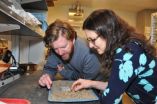(Press-News.org) PHILADELPHIA – A new study finds that football helmets currently used on the field may do little to protect against hits to the side of the head, or rotational force, an often dangerous source of brain injury and encephalopathy. The study released today will be presented at the American Academy of Neurology's 66th Annual Meeting in Philadelphia, April 26 to May 3, 2014.
"Protection against concussion and complications of brain injury is especially important for young players, including elementary and middle school, high school and college athletes, whose still-developing brains are more susceptible to the lasting effects of trauma," said study co- author Frank Conidi, MD, DO, MS, director of the Florida Center for Headache and Sports Neurology and Assistant Clinical Professor of Neurology at Florida State University College of Medicine in Port Saint Lucie, Fla. Conidi is also the vice chair of the American Academy of Neurology's Sports Neurology Section.
For the study, researchers modified the standard drop test system, approved by the National Operating Committee on Standards for Athletic Equipment, that tests impacts and helmet safety. The researchers used a crash test dummy head and neck to simulate impact. Sensors were also placed in the dummy's head to measure linear and rotational responses to repeated 12 mile-per-hour impacts. The scientists conducted 330 tests to measure how well 10 popular football helmet designs protected against traumatic brain injury, including: Adams a2000, Rawlings Quantum, Riddell 360, Riddell Revolution, Riddell Revolution Speed, Riddell VSR4, Schutt Air Advantage, Schutt DNA Pro+, Xenith X1 and Xenith X2.
The study found that football helmets on average reduced the risk of traumatic brain injury by only 20 percent compared to not wearing a helmet. Of the 10 helmet brands tested, the Adams a2000 provided the best protection against concussion and the Schutt Air Advantage the worst. Overall, the Riddell 360 provided the most protection against closed head injury and the Adams a2000 the least, despite rating the best against concussion.
"Alarmingly, those that offered the least protection are among the most popular on the field," said Conidi. "Biomechanics researchers have long understood that rotational forces, not linear forces, are responsible for serious brain damage including concussion, brain injury complications and brain bleeds. Yet generations of football and other sports participants have been under the assumption that their brains are protected by their investment in headwear protection."
The study found that football helmets provided protection from linear impacts, or those leading to bruising and skull fracture. Compared to tests using dummies with no helmets, leading football helmets reduced the risk of skull fracture by 60 to 70 percent and reduced the risk of focal brain tissue bruising by 70 to 80 percent.
INFORMATION:
The study was supported by BRAINS, Inc., a research and development company based in San Antonio, Fla., focused on biomechanics of traumatic brain injury.
To learn more about concussion, visit aan.com/concussion.
The American Academy of Neurology, an association of more than 27,000 neurologists and neuroscience professionals, is dedicated to promoting the highest quality patient-centered neurologic care. A neurologist is a doctor with specialized training in diagnosing, treating and managing disorders of the brain and nervous system such as Alzheimer's disease, stroke, migraine, multiple sclerosis, brain injury, Parkinson's disease and epilepsy.
For more information about the American Academy of Neurology, visit http://www.aan.com or find us on Facebook, Twitter, Google+ and YouTube.
How well do football helmets protect players from concussions?
2014-02-18
ELSE PRESS RELEASES FROM THIS DATE:
How evolution shapes the geometries of life
2014-02-18
Why does a mouse's heart beat about the same number of times in its lifetime as an elephant's, although the mouse lives about a year, while an elephant sees 70 winters come and go? Why do small plants and animals mature faster than large ones? Why has nature chosen such radically different forms as the loose-limbed beauty of a flowering tree and the fearful symmetry of a tiger?
These questions have puzzled life scientists since ancient times. Now an interdisciplinary team of researchers from the University of Maryland and the University of Padua in Italy propose a thought-provoking ...
Theory on origin of animals challenged: Animals needs only extremely little oxygen
2014-02-18
One of science's strongest dogmas is that complex life on Earth could only evolve when oxygen levels in the atmosphere rose to close to modern levels. But now studies of a small sea sponge fished out of a Danish fjord shows that complex life does not need high levels of oxygen in order to live and grow.
The origin of complex life is one of science's greatest mysteries. How could the first small primitive cells evolve into the diversity of advanced life forms that exists on Earth today? The explanation in all textbooks is: Oxygen. Complex life evolved because the atmospheric ...
Researchers warn against abrupt stop to geoengineering method
2014-02-18
As a range of climate change mitigation scenarios are discussed, University of Washington researchers have found that the injection of sulfate particles into the atmosphere to reflect sunlight and curb the effects of global warming could pose a severe threat if not maintained indefinitely and supported by strict reductions in greenhouse gas (GHG) emissions.
The new study, published today, 18 February, in IOP Publishing's journal Environmental Research Letters, has highlighted the risks of large and spatially expansive temperature increases if solar radiation management ...
First biological marker for major depression could enable better diagnosis and treatment
2014-02-18
Teenage boys who show a combination of depressive symptoms and elevated levels of the 'stress hormone' cortisol are up to fourteen times more likely to develop major depression than those who show neither trait, according to research funded by the Wellcome Trust.
In a study published today in the Proceedings of the National Academy of Sciences, researchers from the University of Cambridge have identified the first biomarker – a biological signpost – for major, or clinical, depression. They argue that this could help identify those boys in particular at greatest risk ...
Why tackling appetite could hold the key to preventing childhood obesity
2014-02-18
A heartier appetite is linked to more rapid infant growth and to genetic predisposition to obesity, according to two papers published in JAMA Pediatrics today (Monday).
The studies investigated how weight gain is linked to two key aspects of appetite, namely lower satiety responsiveness (a reduced urge to eat in response to internal 'fullness' signals) and higher food responsiveness (an increased urge to eat in response to the sight or smell of nice food).
The first paper reveals that infants with a heartier appetite grew more rapidly up to age 15 months, potentially ...
Ancient herring catch nets fisheries weakness
2014-02-18
Archaeological data indicate modern herring management needs to take a longer look into the past to manage fisheries for the future says a new study involving Simon Fraser University researchers.
That is one of the key findings in the study, just published online in Proceedings of the National Academy of Sciences (PNAS). SFU researchers Iain McKechnie, Dana Lepofsky and Ken Lertzman, and scientists in Ontario, Alberta and the United States are its co-authors.
The study is one of many initiatives of the SFU-based Herring School, a group of researchers that investigates ...
'It takes a village' -- Community-based methods for improving maternal and newborn health
2014-02-18
A series of studies are published in a special supplement that presents results of the Maternal and Newborn Health in Ethiopia Partnership—a three-year pilot program funded by the Bill & Melinda Gates Foundation with the goal of improving the health of Ethiopian mothers and their newborns. This special issue of the Journal of Midwifery & Women's Health is published by Wiley on behalf of the American College of Nurse-Midwives.
High mortality rates for pregnant women and newborns continue to be a major health concern in Africa, with Ethiopia being one of the most affected ...
Mitosis mystery solved as role of key protein is confirmed
2014-02-18
Researchers from Warwick Medical School have discovered the key role of a protein in shutting down endocytosis during mitosis, answering a question that has evaded scientists for half a century.
The study, published today in the journal eLife, is the first to outline the role of actin, a protein, in shutting down clathrin-dependent endocytosis during mitosis.
Endocytosis is the process by which cells absorb molecules that are too large to pass through the plasma membrane, such as proteins. Clathrin-dependent endocytosis is the most common route for this. Clathrin, a ...
Learning to see better in life and baseball
2014-02-17
With a little practice on a computer or iPad—25 minutes a day, 4 days a week, for 2 months—our brains can learn to see better, according to a study of University of California, Riverside baseball players reported in the Cell Press journal Current Biology on February 17. The new evidence also shows that a visual training program can sometimes make the difference between winning and losing.
The study is the first, as far as the researchers know, to show that perceptual learning can produce improvements in vision in normally seeing individuals.
"The demonstration that ...
Outsmarting nature during disasters
2014-02-17
The dramatic images of natural disasters in recent years, including hurricanes Katrina and Sandy and the Tohoku, Japan, earthquake and tsunami, show that nature, not the people preparing for hazards, often wins the high-stakes game of chance.
"We're playing a high-stakes game against nature without thinking about what we're doing," geophysicist Seth Stein of Northwestern University said. "We're mostly winging it instead of carefully thinking through the costs and benefits of different strategies. Sometimes we overprepare, and sometimes we underprepare."
Stein will ...



